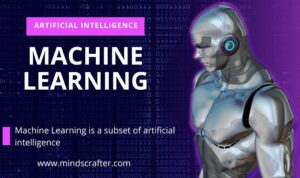
Machine Learning vs Artificial Intelligence
Machine Learning vs Artificial Intelligence:
In the modern world of technology, the terms machine learning (ML) and artificial intelligence (AI) are often used interchangeably. However, a significant difference between the two needs to be more understood. In simple terms, machine learning is a subset of artificial intelligence, but the distinction between the two is crucial. Machine learning involves training machines to learn from data and improve performance in a specific task without being explicitly programmed.
Artificial intelligence, on the other hand, is a broader concept that encompasses the ability of machines to perform tasks that typically require human intelligence, such as reasoning, learning, and problem-solving. This article will delve deeper into the differences between machine learning and artificial intelligence and explore how they are applied in real-world scenarios. Whether you are a business owner, a tech enthusiast, or just someone curious about these cutting-edge technologies, this article will provide valuable insights into these fascinating fields.
What Is Machine Learning?
Machine learning is a branch of artificial intelligence that involves the development of algorithms that can learn and improve from data without being explicitly programmed. In other words, machine learning algorithms can learn from experience and improve their performance over time. Machine learning algorithms are designed to analyze large amounts of data, identify patterns, and make predictions or decisions based on that data.
Types of Machine Learning:
There are three main types of machine learning: supervised learning, unsupervised learning, and reinforcement learning.
Supervised Learning:
Supervised learning involves training a machine learning algorithm on a dataset that has already been labeled or classified. The algorithm learns to associate specific input data with corresponding output data. For example, a supervised learning algorithm might be trained on a dataset of customer purchase histories and corresponding purchase amounts. The algorithm would learn to predict the purchase amount based on the customer’s purchase history.
Unsupervised Learning:
Unsupervised learning involves training a machine learning algorithm on a dataset that is not labeled or classified. The algorithm learns to identify patterns or relationships in the data. For example, an unsupervised learning algorithm might be trained on a dataset of customer purchase histories. The algorithm would learn to group customers with similar purchase histories together.
#### Reinforcement Learning
Reinforcement learning involves training a machine learning algorithm to make decisions based on feedback from its environment. The algorithm learns to maximize a reward signal while interacting with the environment. For example, a reinforcement learning algorithm might be trained to play a game. The algorithm would learn to make decisions that maximize its score in the game.
### Applications of Machine Learning
Machine learning has various applications in various industries, including healthcare, finance, marketing, and more. Some examples of machine learning applications include:
– Fraud detection in finance
– Disease diagnosis in healthcare
– Customer segmentation in marketing
– Predictive maintenance in manufacturing
– Speech recognition in telecommunications
– Personalized recommendations in e-commerce
What Is Artificial Intelligence?
Artificial intelligence is a broad field that encompasses the ability of machines to perform tasks that typically require human intelligence, such as reasoning, learning, and problem-solving. AI involves the development of algorithms and computer programs that can perform tasks usually requiring human intervention.
Types of Artificial Intelligence:
There are two main types of artificial intelligence: narrow or weak AI and general or strong AI.
#Narrow or Weak AI:
Narrow or weak AI refers to AI that is designed to perform a specific task. For example, a machine learning algorithm that is designed to detect spam emails is an example of narrow or weak AI.
#General or Strong AI:
General or strong AI refers to AI that has the ability to perform any intellectual task that a human can. General AI is still theoretical; no machine has been developed to match human intelligence in all areas.
Applications of AI:
Artificial intelligence has various applications in various industries, including healthcare, finance, education, and more. Some examples of AI applications include:
– Chatbots in customer service
– Virtual assistants in personal computing
– Autonomous vehicles in transportation
– Image recognition in security and surveillance
– Natural language processing in healthcare
Differences between Machine Learning and Artificial Intelligence:
While machine learning is a subset of artificial intelligence, the two have some significant differences. Machine learning involves the development of algorithms that can learn and improve from data without being explicitly programmed, while artificial intelligence consists of developing algorithms and computer programs that can perform tasks that would typically require human intervention.
Another key difference between machine learning and artificial intelligence is their level of complexity. Machine learning algorithms are relatively straightforward and can be developed using a small amount of data. On the other hand, artificial intelligence algorithms are much more complex and require significant data and computing power to develop.
Machine Learning vs Artificial Intelligence: Which is Better?
The question of which is better, machine learning or artificial intelligence, is challenging to answer. Both technologies have their strengths and weaknesses, and the choice of which to use depends on the specific application.
Machine learning is best suited for applications with a large amount of data available and where the problem can be defined in terms of input and output. For example, machine learning is well-suited for fraud detection, customer segmentation, and predictive maintenance applications.
On the other hand, artificial intelligence is best suited for applications where the problem is ill-defined, and there is no clear input-output relationship. For example, artificial intelligence is well-suited for natural language processing, image recognition, and autonomous vehicle applications.
Future of Machine Learning and Artificial Intelligence:
The future of machine learning and artificial intelligence is bright, and both technologies are expected to play an increasingly important role in various industries. In the coming years, we can expect to see more sophisticated machine learning and artificial intelligence algorithms capable of solving complex problems and making decisions with high accuracy.
Conclusion:
Machine learning and artificial intelligence are two of the most exciting and cutting-edge technologies of our time. While they are often used interchangeably, a significant difference between the two needs to be understood. Machine learning involves the development of algorithms that can learn and improve from data without being explicitly programmed, while artificial intelligence consists of developing algorithms and computer programs that can perform tasks that would typically require human intervention. Both technologies have their strengths and weaknesses, and the choice of which to use depends on the specific application. The future of machine learning and artificial intelligence is bright, and we can expect to see more sophisticated algorithms that are capable of solving complex problems and making decisions with a high degree of accuracy.

Pingback: Applications of Machine Learning